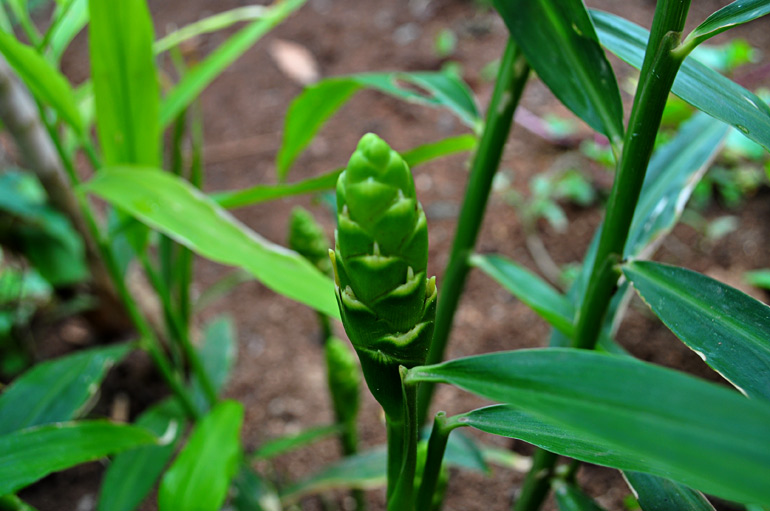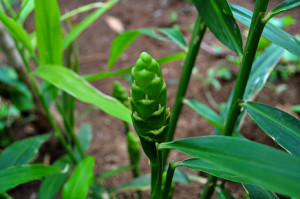Ginger (Zingiber officinale) is a tropical perennial that is native to south China. From there it spread to the so-called Spice Islands (the Moluccas) and then to the rest of tropical Asia and finally to Africa and the Caribbean. India is now the largest producer of ginger in the world.
In the US, it can be grown as a perennial in zones 9 through 12. The rest of us either have to grow it in containers and bring our plants indoors during the winter or we have to start our plants indoors and then plant them in our gardens after all danger of frost has passed. There are ornamental gingers that are used in both tropical and sub-tropical landscapes because of their brightly colored flowers or variegated foliage, but they do not produce the flavorful rhizomes of culinary ginger. Culinary ginger flowers are a less showy yellow and the foliage is green with no variegation. The plants grow to 2 to 3 feet in height. Technically, ginger is a spice because the part of the plant that is used is the rhizome, but most people grow ginger as an herb in their gardens or in containers.
In the tropics, you can plant your ginger directly in your garden. All you need to do is buy a “hand” of ginger at the grocery store making sure that it has “eyes”. Like potatoes, the eyes are what will produce the foliage. Cut the rhizome (hand) in 1- to 2-inch pieces, making sure that each piece has at least one eye, then allow the pieces to dry out for a few days.
Plant them in a shady or semi-shady spot that is protected from wind. Plant the pieces with the eye(s) facing upwards about 3 inches deep in rich, well-drained soil. Water thoroughly after planting and keep moist, but not wet, while the plant is growing. When the foliage starts to die back in the fall, it’s time to harvest the rhizome. Dig it up, clean it up by gently brushing off the soil and then freeze it for later use. You can harvest small amounts of ginger during the growing season by carefully digging around the edges of the rhizome and cutting off small pieces. These, small early harvests are known as “green ginger” and are not as flavorful as the mature rhizomes that are normally harvested at the end of the growing season.
Outside of the tropics, you can still grow ginger in your garden but you will have to start it indoors first because it takes 8 to 10 months to mature for harvest. Plant your pieces of rhizome 3 inches deep in a container just as you would if you were planting it in your garden. Keep your plant moist until the soil in your garden is at least 68⁰F. Ginger will go dormant in colder soils. When your soil is warm enough, you can transplant your ginger from your container into your garden in a nice shady spot that is protected from the wind.
You can also grow ginger exclusively in a container. A 14-inch container will hold up to 3 pieces of rhizome. Plant them 3 inches deep and water regularly. You can use slow release fertilizer or regular feedings of liquid fertilizers throughout the growing season. You can put your containers outdoors in the late spring/early summer when night time temperature reach at least 77⁰F and then bring them in again in the late summer/early fall when the night time temperatures go below 77⁰F. Just like in the garden, you can harvest small pieces from the edges of the rhizome before maturity if necessary. When the foliage starts to die back, it’s time to harvest your rhizome(s). Whether harvesting from your garden or container, don’t forget to cut a few pieces with eyes from each rhizome which you can then use to start new plants.




12 Comments on “Ginger”
I live in Zone 7b…. any chance I could start ginger, or even turmeric, indoors and then plant it deeply outside? Would it survive our VA winters?? Here’s hoping… 🙂
Sorry, but ginger is a tropical plant and cannot survive even your mild winters. The problem is that it has a 10 month growing season which means that it needs 10 months of tropical temperatures. You will need to start it indoors in the winter and then transplant it outside when temperatures when your soil reaches 68 degrees F. When the foliage dies, it is time to harvest. Harvest the entire root. Replant what you want to grow for next year in a container indoors. Keep that container indoors until the soil has warmed next year. Ginger is not a plant that you can leave outdoors year round if you live outside of the tropics.
I live in zone 7b and left some turmeric out just for an experiment. Died immediately the first frost. It sure does grwo easily though. If you dig up a corner and it is still white, it needs more time.
I have been trying to grow ginger in CA (zone 9). The plants have grown, but are about a foot tall. Has been in the ground for about 8 months now. The turmeric has grown beautifully and has flowers, but the gingers seem to be stuck at the 1 ft range.
Any advice?
Sounds like the ginger is getting too much sun. It won’t grow well if it is in the sun. Ginger is a shade plant while turmeric is a sun plant. Plant turmeric in a sunny spot. Plant ginger in a shady spot.
When it flowers, does this affect the rhizome size? I live in SW florida and looks like my ginger plant is thriving. The leaves are starting to brown though, is this a cue to harvest? I planted the rhizomes early spring.
Flowering does not affect the size of the rhizome. Ginger has a 10 month growing season, so it should be ready to harvest soon. It’s best to wait until the foliage has died completely before harvesting.
I planted some ginger rhizomes this spring, just playing around to see what would happen. They grew nicely and are about 18” tall. It’s fall now and getting into the low 50’s at night. No blooming from the ginger and I’m presuming not ready to harvest. Should I bring these plants inside and replant when the soil warms enough next spring? Should or can the leaves be trimmed if indoor wintering over is an option?
Thanks!
Yes, you should bring it indoors immediately. Ginger is a tropical plant and can’t tolerate cold temperatures. Continue watering and leave the foliage alone. Depending on when you planted it, the foliage on your ginger will begin to die in a few weeks or months. When that happens, the ginger is ready to harvest. Dig it up, put some aside and freeze the rest for use during the upcoming year. Plant the pieces that you put aside to grow for harvest next year.
I potted my ginger, this is the second fall that I’ve brought it into the house. Last fall the foliage died back and I did not harvest at all. This past spring it grew even taller than the first spring and for the first time I learned that ginger has blooms! They were so cute! So, do I really have to harvest and freeze, or can I harvest and leave?
Hello Herb Lady! I hope my comment finds you and your ginger thriving…I potted my ginger and this is the second fall that I have moved it indoors. The first year I did not harvest at all and this summer I learned that ginger has flowers. They are so cute! My question is do I have to harvest and freeze or can I harvest and leave?
You can harvest your ginger or leave it and enjoy the lovely flowers.